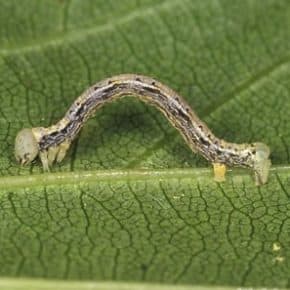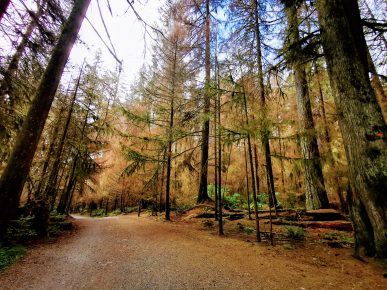Mid-July if you took a walk through the forest, you likely ran into hundreds of tiny hanging caterpillars. The larvae were lunching on hemlocks and other conifers, in the matter of weeks turning the hillsides from green to brown. Unfortunate timing also brought a heat dome to Lynn Valley and the result is a forest stressed and facing long-term deterioration. We spoke with UBC’s Dean of Forestry for his thoughts on looper moths, cedar die-off, and the future of local forests.
Local impacts
The change was fast. The forests on Mt. Fromme and through Lynn Canyon were green – dry from lack of rain but still green. Then in just a couple of weeks, some ridges clearly seemed more brown and red than green. The quick change took even forest experts by surprise.
“When someone told me about earlier this year I was quite surprised because I do spend a lot of time in the North Shore mountains,” said John Innes, a West Vancouver resident, professor, and dean of the Faculty of Forestry at the University of British Columbia. “The hemlock looper is actually quite localized, but where it is occurring it is significant. You may have noticed that the moths are now flying. We had exactly the same last year.”
Despite his many dog walks, it wasn’t until Innes flew over the area last month that he saw the full impact of the hemlock looper moths on Stanley Park, parts of Lighthouse Park, and the Lynn Valley area. Other portions of the North Shore remain largely untouched. The native insect is in the middle of a three-year cycle, he said. They defoliate hemlocks, firs, and other trees.
The loopers
“Normally the insect effects beginning in early July, so that is why you see very rapid effects,” said Innes. “The trees aren’t actually dead. The foliage is affected. The foliage has died but it is possible – it’s not a 100 percent certain but it is possible – these trees will recover in a year or two or a bit longer.”
As the North Shore forests are midway through a natural multi-year cycle that occurs every 11 to 15 years, some trees were also hit hard last year.
 “What we know is the ability to recover is strongly linked to the amount of defoliation and so we are seeing that if trees are completely defoliated there is a lower chance of recovery,” he said. “The other problem is that if the tree was affected last year, its reserve would be depleted. If this year it is again defoliated, that depletes its reserves again and it may not produce foliage next year and it may die.”
“What we know is the ability to recover is strongly linked to the amount of defoliation and so we are seeing that if trees are completely defoliated there is a lower chance of recovery,” he said. “The other problem is that if the tree was affected last year, its reserve would be depleted. If this year it is again defoliated, that depletes its reserves again and it may not produce foliage next year and it may die.”
There is some question of where we are in the looper moth cycle. The District of North Vancouver states we are in the last year of a three-year cycle, whereas Innes has a different opinion.
“We had one last year, there is this year and we may get another one next year, and then it should die down again.”
The long-term impacts
Lynn Valley’s forests are not just dealing with a looper moth outbreak, they are also impacted by climate change and the sudden heat dome that occurred in late June/early July.
“The heat plays a role in overall forest health – particularly cedars,” said Innes. “We are seeing over the years an increase in mortality for cedar across the North Shore mountains, particularly young cedars.
“Within the forest, there is always some mortality. Like the human population, there is always one or two people who get an illness and ultimately die, unfortunately, and age-related mortality. Trees can reach a very old age but very few trees that grow in the forest actually reach that old-growth status. The majority die before then for all sorts of reasons, so what we are seeing is accelerated mortality. If it is bad, it can change the nature of the forest.”
Cedars are the cornerstone of North Shore forests. Without young trees slowly growing there will likely be a shift in the local ecosystem, he said.
“There is going to be a problem in the future because there are no young cedars. There will be hemlocks and firs but we will lose the cedars are the oldest living trees in the forest and that will be quite significant in the future,” said Inness. “What we also can get is destabilization.”
The slope safety
 Our mountainside community relies on the trees to keep the forest where it is – on the hillsides. The roots of healthy trees retain the soils that help bushes and younger plants grow – continuing the cycle.
Our mountainside community relies on the trees to keep the forest where it is – on the hillsides. The roots of healthy trees retain the soils that help bushes and younger plants grow – continuing the cycle.
“Dead tree roots slowly decay. What we have seen is that it takes three to four years for the soils to be affected,” said Innes. “If you have a very strong rain or the soil is saturated, the soil’s ability to hold in place is at risk and you may see a landslide.”
The District of North Vancouver is aware of the shift in forest health.
“At this time, we do not know how many of those distressed trees will survive and we likely won’t know until next spring,” said Cassie Brondgeest, communications coordinator for the DNV. “There are many variables that will contribute to tree recovery including looper moth activity and future weather patterns. District staff are working closely with subject matter experts, our neighbouring municipalities, Metro Vancouver and the Province to monitor the situation and to determine next steps. This is a dynamic situation and much will depend on what happens next year.”
Typically, if remediation is required it would involve replanting trees, said Innes.
“We have a period of a few years where there is a high risk until the new roots gain enough strength,” he said. “It isn’t everywhere but it is a problem for certain slope conditions.”
Immediate concerns
While slope destabilization is an issue to closely monitor, Innes feels there is an immediate concern residents should more fully educate themselves about: fire risk.
“Just because it is a rain forest does not mean that it’s not going to burn in the right conditions. And this year has given us the right conditions,” he said. “I don’t think we are quite ready. People in the interior are familiar and know about evacuation orders, but if that situation were to happen in the District of North Vancouver a lot of people would not know how to respond or what to do.”
Despite this week’s rain, the heat of summer and looper moths have created a situation that remains high risk.
“Once trees drop their foliage, the red browns stuff is very dry and it does increase risk. If the trees are dead they will gradually break down and increase the risk,” said Innes. “In terms of the North Shore, the primary risks are the availability of fuel, dryness of the fuel, and the igniting effects. What you would be looking for, on the North Shore is the human risk.”
Big fires on the North Shore are not unheard of, he said. Exploring Cypress Bowl is one place where we can see the effects of local forest fires. He emphasizes we aren’t immune and need to learn more about fire prevention.
“I was out walking and I was thinking that this is so, so dry and it would easily be set off by a cigarette.”
Looking for more?
There’s always something fun and exciting happening in Lynn Valley. Check out our Community Events Calendar or learn more about Local Activities, Mountain Biking or Hiking and Walking Trails.

